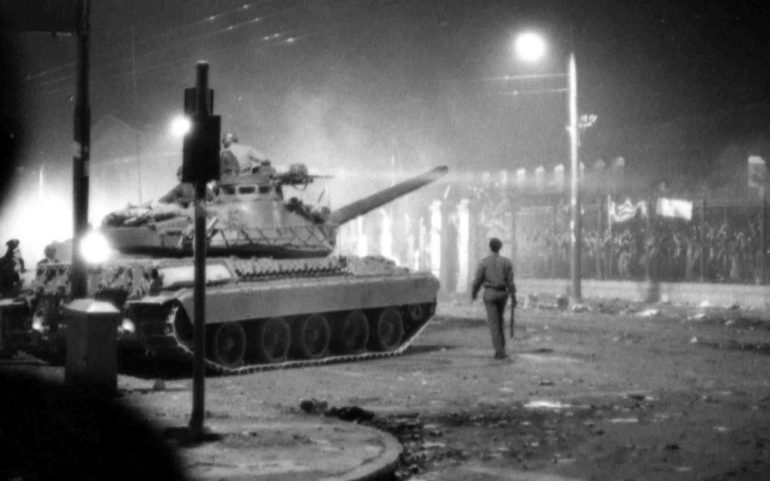Sent by Junta of Colonels on the night of November 17, 1973 to violently and murderously suppress the student uprising at the National Technical University of Athens.
He was called "educated" with a tragic sense of irony after the bloody attack, as it was the only chariot that ever entered a university campus.
The chariot that invaded the Polytechnic on the fateful night would reveal in all its dark grandeur the coup plotters' plan for another blow to democracy.
Only in the end things would boomerang, giving a strong slap in the face to the Seven Years, which would soon collapse like a paper tower. Stained with Greek blood.
Nothing was written in the chariot diary for the night of November 17, 1973. And there was good reason for that. His mission was of the utmost importance for the conspiratorial regime, to end once and for all with the massive and dynamic manifestation of popular dissatisfaction with the April Coup that passed in the nation's consciences as the Polytechnic Uprising.

Students and democratic citizens occupied it Polytechnic on November 14 until the dawn of the 17th of the month, when the tank knocked down the gate of the institution and tarnished the modern Greek history.
And while the story is now well known and well certified by testimonies and audiovisual material, it is rarely told through the mouths of its black protagonists. Because they are obviously ashamed or remain unrepentant, right "droplets" of the regime, finding their place in the modern far-right landscape of the country.
If it were not for the lens of the photojournalist Aristotelis Sarrikostas to immortalize the moment of the tank invasion at the Polytechnic and the film of the Dutch cameraman Albert Kurad to give flesh and blood to the event, the juntas and their fans will still police that "not the slightest thing happened at the Polytechnic".
Unfortunately for them, the photos of Sarrikostas went around the world just a few hours after the bloody events, through the Associated Press, and thus the whole planet learned what the junta had done to the Greek people.
Today we will hear what the driver of the armored chariot, A. Skevofylax, had to say, who sowed death at the Polytechnic. He had spoken only once to Kostas Hatzidis of "Vimatos" 30 years after the events. Once arrived and left over…
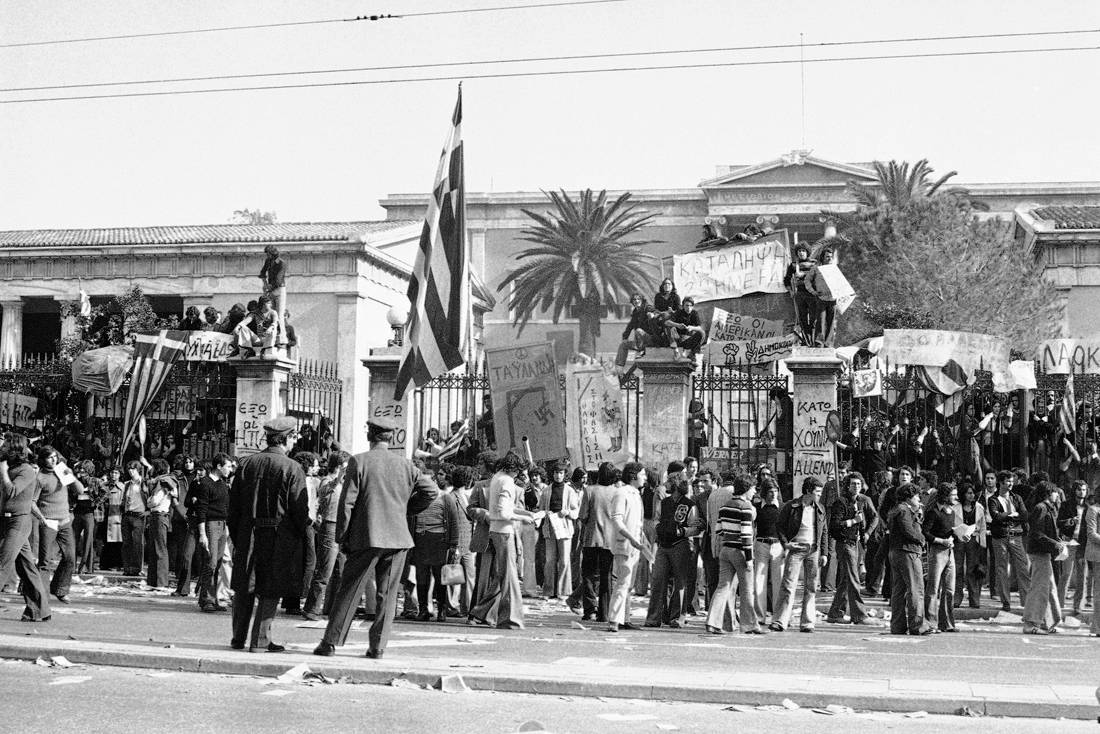
"I was on duty that day. I had ten months in the army ", begins the narration of the reserve soldier A. Skevofylax," I was an instructor at the Armor Center in Goudi. At that time, the "black hats" were a body of selectors. I went voluntarily. As soon as the episodes started, we went on alert.
"The communists are burning Athens" they told us and we believed them. I remember in the camp some people had radios and we secretly listened to the Polytechnic station. "Paliokommunia" you will have a good time! ", We said".
And so they moved to the Polytechnic, thirsting for blood, faithful to the demands of their junta commanders: "At 1:15 in the morning of November 17, we arrived at the intersection of Alexandra and Kifissia avenues. A little later we were crossing Alexandras, when at the height of IKA, at the Sonia stop, we stopped because the road was closed. There were roadblocks, fires and immobilized buses. With various maneuvers from left to right, back and forth, I opened the way and we proceeded ".
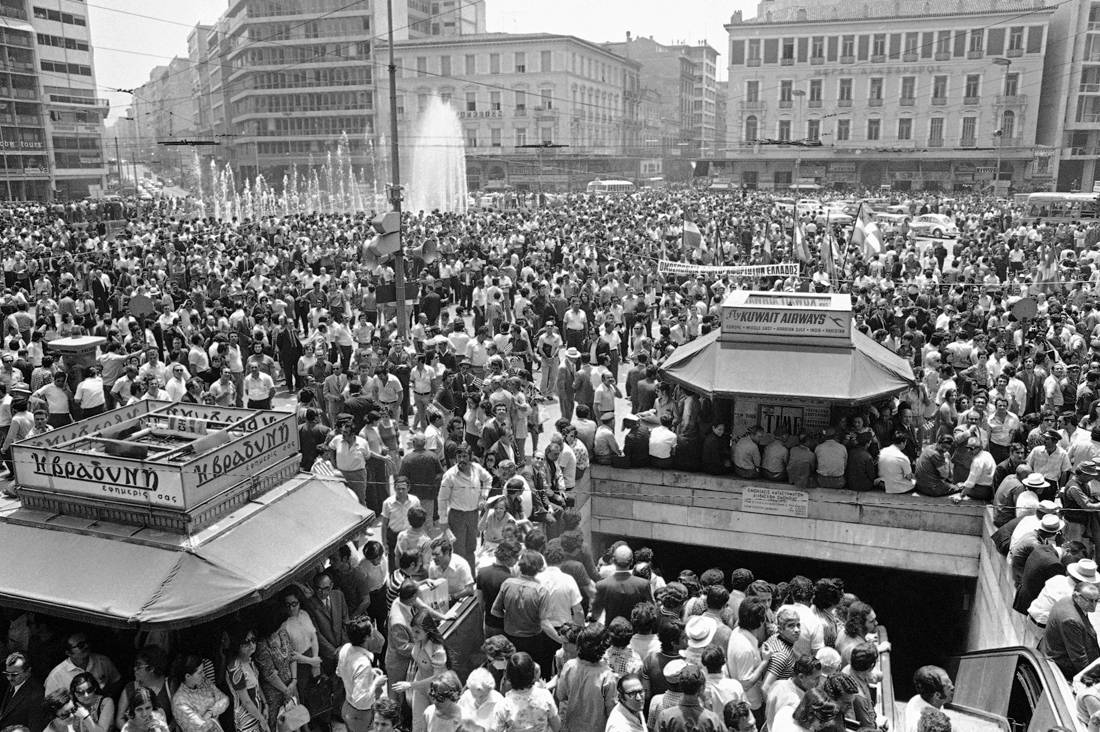
The road to the Polytechnic seemed long: "When we reached the intersection of Alexandra Avenue and Patision Street, we were ordered to stop. There, in Egypt Square, we stayed for about an hour. I remember people shouting at us "we are brothers, we are brothers". I wanted to eat them. "I saw them as parasites."
The Athenians were informed about the exit of the tanks from Goudi by the speaker of the Polytechnic, Dimitris Papachristos. Despite the interventions of KYP, the radio of the rebellious students will convey to the Athenians the creepy whistle from the tracks of the tanks.
The announcer appeals to the "military youth" not to strike: "Children, our brothers, the soldiers, the fortress of freedom, the only part of it will not strike Greece which is free. We have no weapons. We only offer our breasts openly. People of Athens, all together the slogan: people and army together. The army will not strike! "…
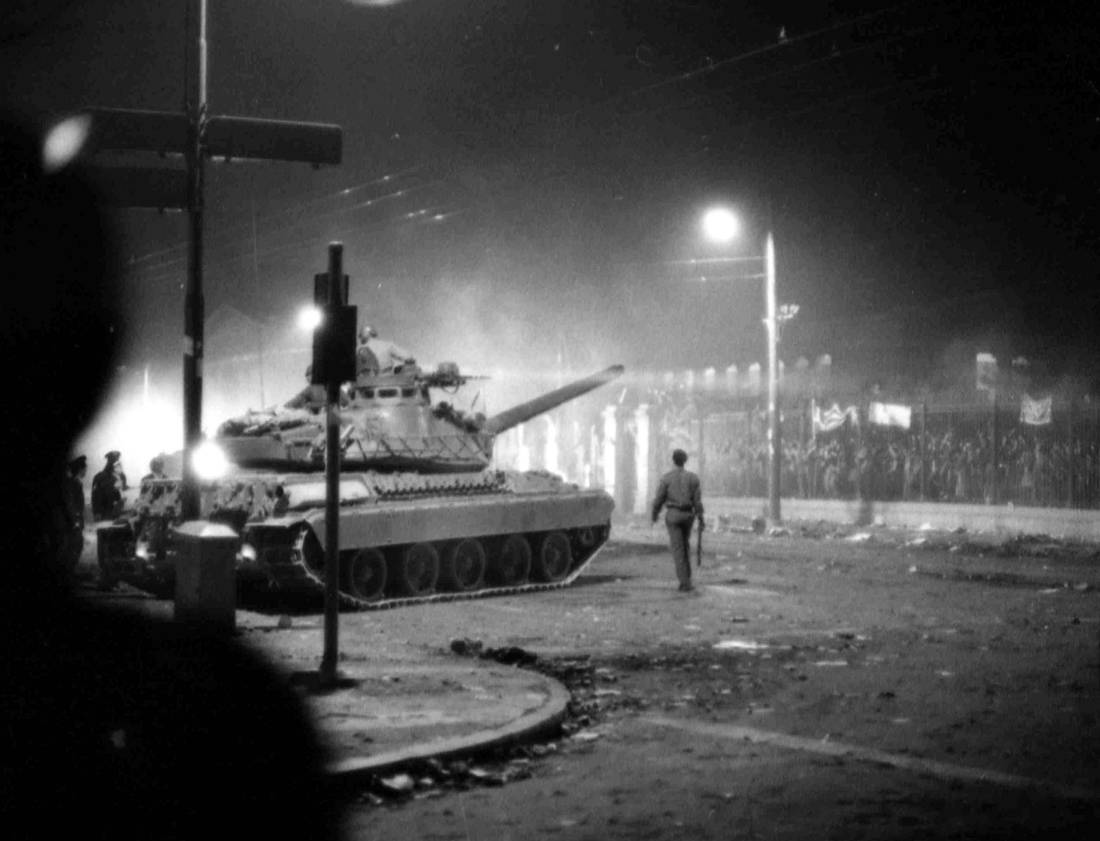
According to the driver, the operation was named "Evacuation of the Polytechnic" in order to drown the uprising in blood. The 5 armors are advanced towards Museum and now the clock reads 2:00 in the morning.
"Arriving in front of the door, I turned the chariot towards the Polytechnic, with the cannon turned backwards. I remember getting up from my seat and me and the other crew. Dozens of students were hanging from the railings, while hundreds were in the courtyard. They looked panicked. And I, to think, that I saw them as mammoths that I wanted to eat "!".
A quarter before 3:00 in the morning, the military gives the students a short deadline to leave the Polytechnic, to surrender. Some people try to unlock the main gate, but they do not succeed. It is this "Mercedes" that blocks its opening. The head of the armor gets annoyed, screams: "Tsoglania, you are killing the army!" and signals the launch of the chariot.
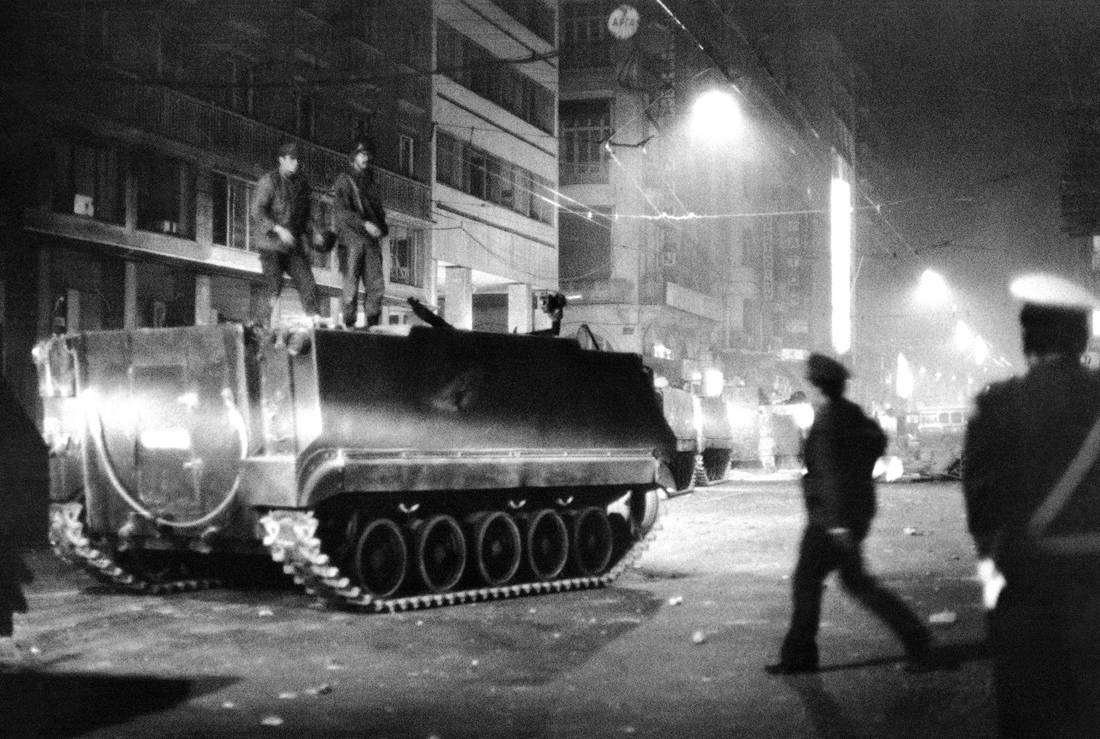
Skevofylax continues: "Then the ground guide of the chariot came and said to me: '' We will go in, we will knock down the gate. Get ready!''. I took a seat and started. I did not see many things, I did not have a good field of vision, because I was looking out of the chariot window. Ten inches before the door, I stopped. I stopped deliberately. This can be seen in the video of the time. During the braking, the students, frightened, went backwards. "If I had rushed in, I would have killed dozens of people who were hanging on the railings at the time."
"The barred door fell immediately. Behind the iron gate was parked the Mercedes which the students had put there to block the entrance. I made it ointment. The left caterpillar melted it. As soon as the gate of the Polytechnic fell, the police raided to arrest the students. A little later, I also got out of the chariot and entered the Polytechnic. There was no dead. But there could also be dead. "
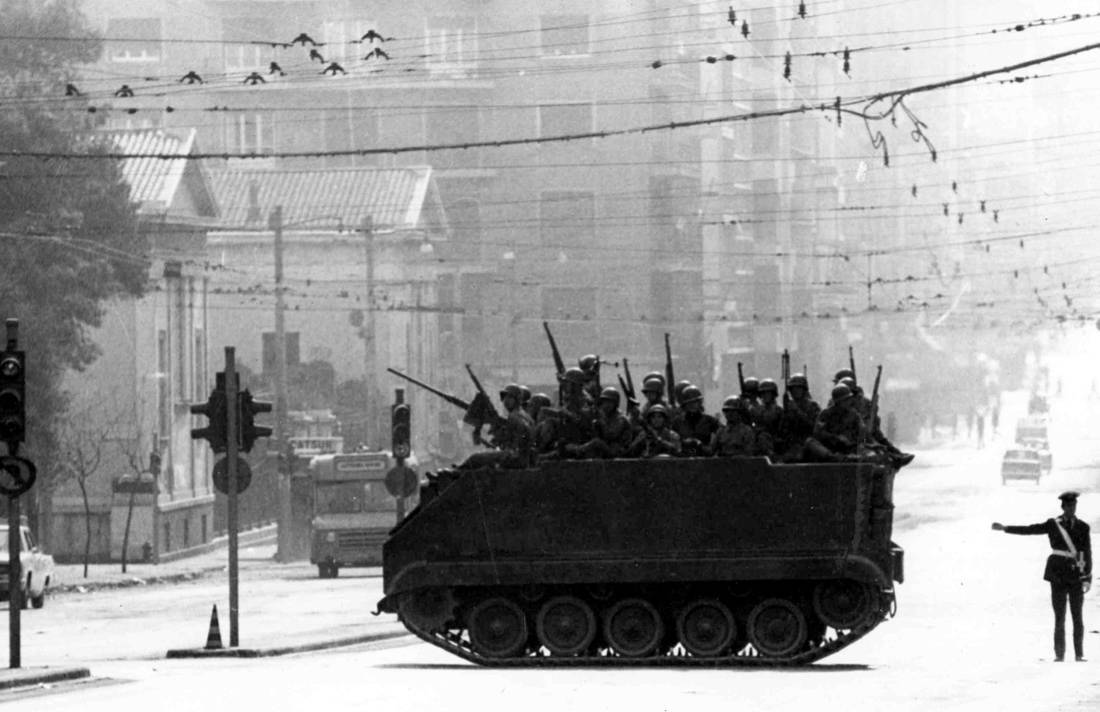
Inside the Polytechnic there is a pandemonium. Informative is the description given by prosecutor Dimitris Tsevas in the report he wrote in 1974 on the events of the Polytechnic:
"Frightened and embarrassed, the students are overwhelmed by the terrible agony in the face of the ultimate danger. Under the pressure of many people, part of the railings towards Stournari Street is demolished. And through the created opening the students come out en masse. Neon, however, begins martyrdom for them. "Insults are fired at them and those who are persecuted are brutally abused."
Skevofylax confirms: "Police were chasing and beating the students wherever they were found. "If it were not for the Lokatzides to stop them - I remember that many times they were caught in the arms with them - I do not know and I do not know what would have happened".
There are many soldiers who try to form a corridor for students to cross safely. Underlines in this respect the Cheva conclusion:
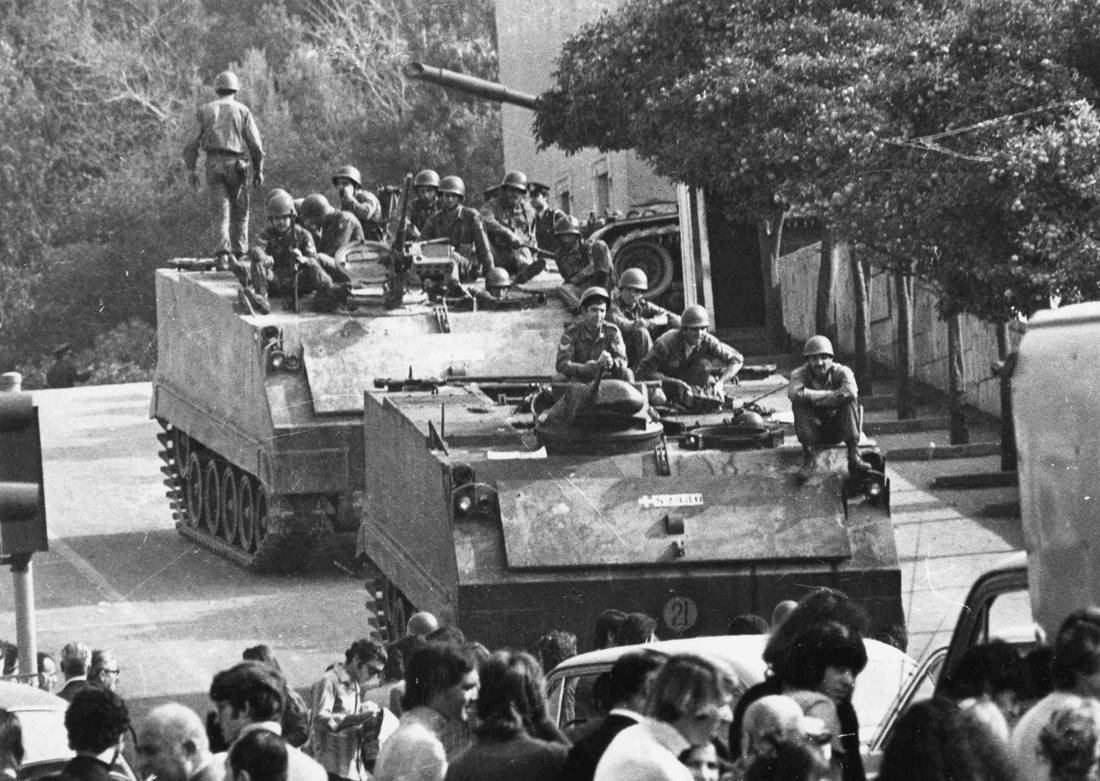
"In front of the gate of the Polytechnic, a corridor is created under the soldiers, through which the exits pass, heading towards Tositsa Street, and inside the Polytechnic, they help, protect and hold on the shoulders of many weak people so that they can jump over the high ridge. "Incidents between the military and the police are also taking place in the first attempt to protect students from the persecution of others."
Hundreds of students pour into the surrounding streets, run away, save their lives, but become targets snipers.
"However, as they leave the Polytechnic, anxious surprises await them. They are being chased and beaten everywhere. At the corner of Tositsa and Bouboulinas streets, men of KYP in political garb beat and shoot at them mercilessly, while on the roof of one of the local buildings they have installed a machine gun. "On the roofs of the surrounding buildings, it is pointed out that the Free Police intends to carry out their murderous work".
The prosecutor's finding is catapult: "Groups of thugs and dangerous rodents of the peace of the place demonstrate the criminal nature of the unfortunate students who leave the Polytechnic in large numbers." The "thugs" are "ESA men in political garb", who do not hesitate to abuse even a university doctor at the junction of Patision and Stournari streets, who, together with his wife, had rushed to help the defenseless students.
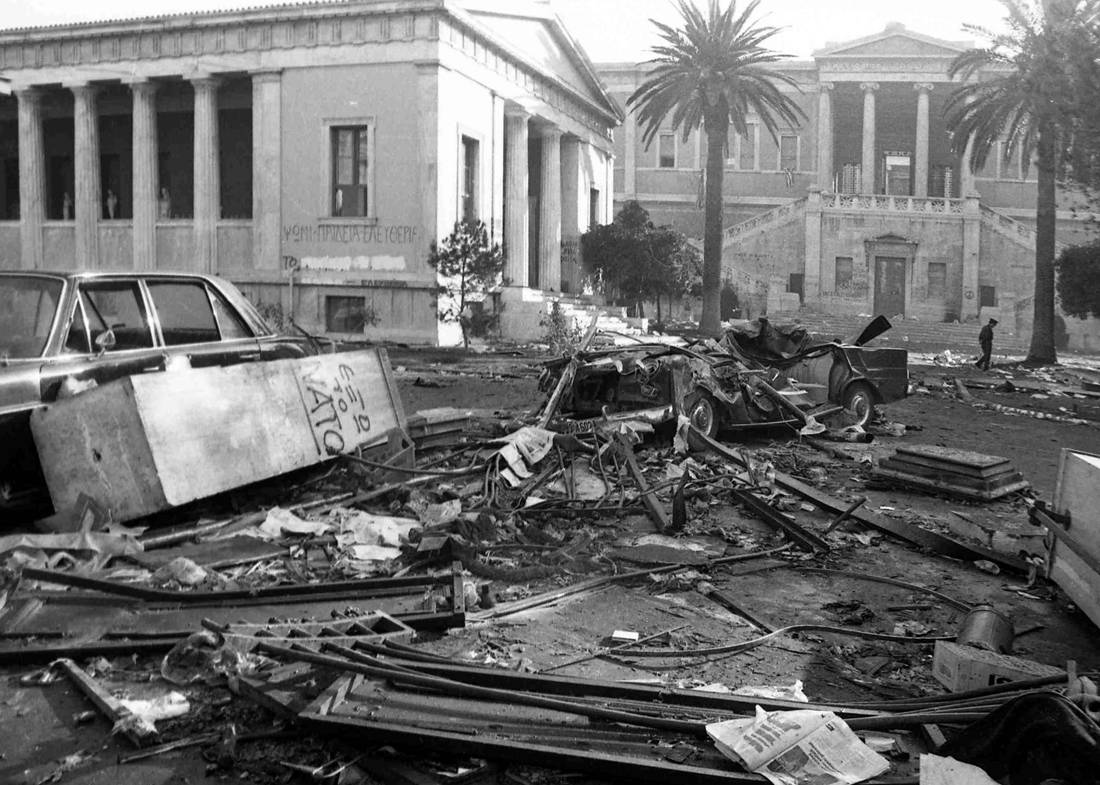
"Most of the wounded fell into this pandemonium of outbursts of shouting, screaming, screaming, stalking and shooting."
The Skefylax soldier saw with his own eyes the situation described by the Cheva report after the invasion. He still remembered, 30 years later, the terror that followed the violent attacks by the police.
"In the courtyard of the Polytechnic they were very hit, I remember seeing many injured, while three or four were collapsed, motionless. I do not know if they were dead. I did not look to see. At one point a student rushed at me and said, "What do you understand now that you came in?"
I left. I took out my pistol and, proposing it, I turned and said to him, screaming: "Shut up, you idiot, I will not clean you." This student does not know how lucky he was at that moment… If he said one more word, I would kill him! I was like that. A fascist».
Of course, the students did not treat him in the same way, as he tells us: "As the students passed, I remember throwing packs of cigarettes and all the supplies they had with them into the tank. When we returned to Goudi, the chariot looked like a kiosk. As long as I think the students gave us sandwiches and cigarettes after what we did to them… I can not forgive this thing to myself. I think about what I went and did… ".

When he returned to Goudi, at the Armored Base, Skevofylax was received with exchanges and cheers. He was the face of the moment, the man who taught the "old communes" a valuable lesson.
"When we returned to the camp, I became a hero. The military congratulated me. Then I felt that I was someone, that I did something good, something big. I had become the hero who disbanded the enemies of the homeland, the "old communes", as we called the students then. That's what they told me, that's what I believed. I felt proud. "I was also a fascist."
Thirty years later, when his life taught him the only real and valuable lesson he knows, that of survival, the faithful soldier changed course.
"They had a great soul. "They were lads", said in the interview of "Vimatos" the 50-year-old bio-wrestler for the students, the young people and the workers who fought for the fall of the junta. "I am ashamed of who I was, of what I did."
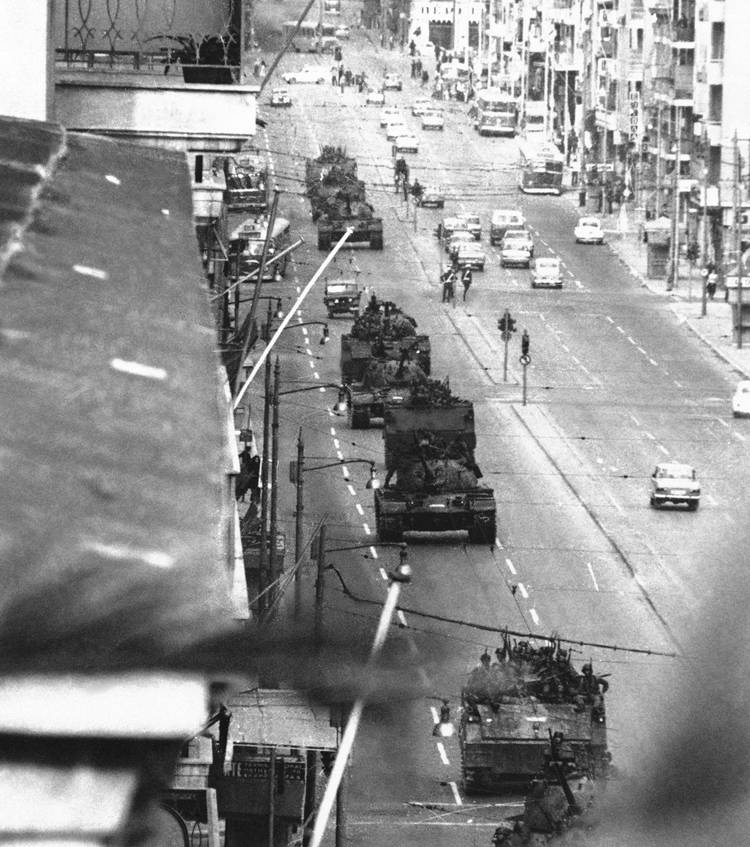
After the Metapolitism, the reserve soldier A. Skevofylax will be at the border. "When I was fired, everything had changed inside me." A citizen now, he returned to the western districts of Athens, next to his parents and two brothers, looking for the real estate.
"During my day job, my life changed 180 degrees. I did any job you can imagine. Worker I realized that I can not have the same requests as employers. I, who was taught to hate the communists, voted twice KKE»!
In the anonymity of the capital and the toil of everyday life, Skevofylax the soldier disappeared. Only once did he get into a difficult position. "At work years ago, someone heard me being called and asked me if I had anything to do with the '' doors '', as he said, of the Polytechnic. "He is my cousin, far away. "He was killed in a car accident," I replied.
He concludes: "I am a man who has never been 20 years old. Reserve soldier A. Skefylax was killed in a car accident! My friends do not know who I am or anyone in the neighborhood. Only my wife knows that. I told her after years. I have not told my children yet. "
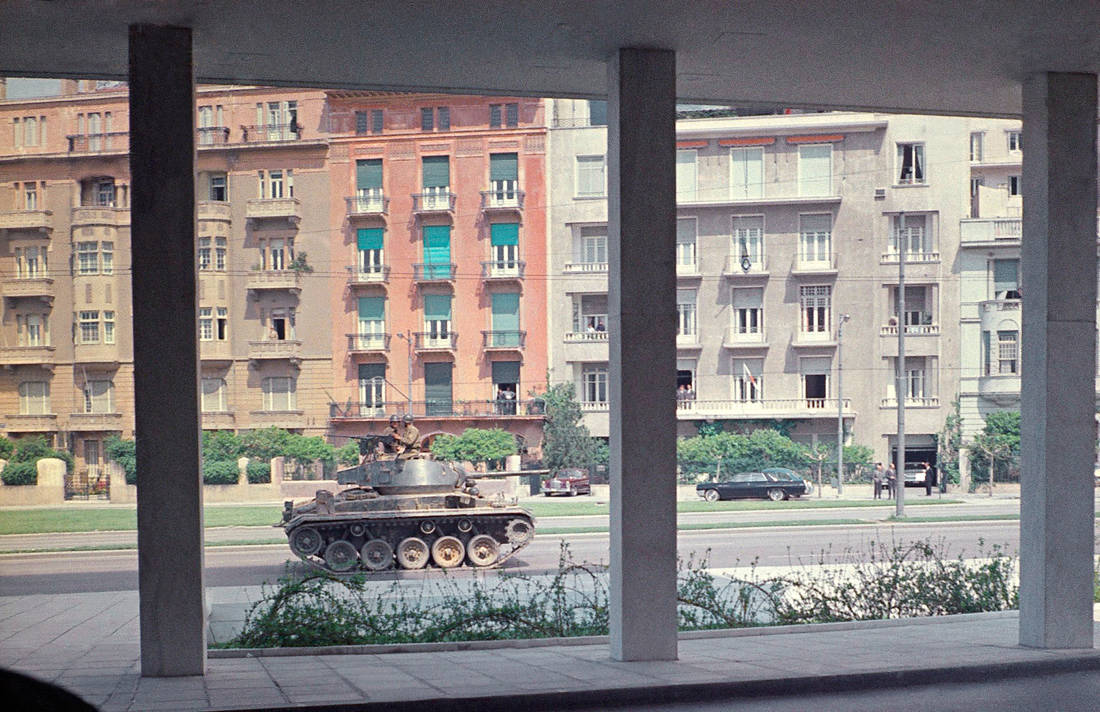
The tank driver came in contact with the relentless nature of life and left the far-right rhetoric where it's needed, in the junk of history. Its history, part of the collective history of our country, remains a beacon that even the deceived of the dictatorship can change.
"I do not know if it makes sense, but I would like to say a big apology to them," he concluded in his historic interview. An apology always makes sense…
